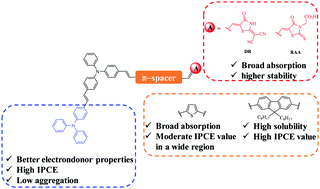Rhodanine-based light-harvesting sensitizers: a rational comparison between 2-(1,1-dicyanomethylene)rhodanine and rhodanine-3-acetic acid†
Abstract
Here, we report the synthesis and photophysical and electrochemical characterization of new dyes based on 2-(1,1-dicyanomethylene)rhodanine and rhodanine-3-acetic acid as anchoring units to TiO2 surfaces. In our design, we employed bis-triphenylamine(bis-TPA)-based electron-donor and co-donor units linked through thiophene and fluorene spacers to these rhodanine-based anchoring acceptors. A detailed relationship amongst the dye structures, their photophysical and electrochemical properties and their photovoltaic behavior is described in this work. The new dyes showed broad absorption spectra and interesting emission properties. Likewise, a strong push–pull electronic interaction was also predicted by DFT theoretical calculations showing that the HOMO level was exclusively localized on the TPA-based co-donor units, while the LUMO level was mainly localized on the rhodanine-based acceptors. Dye RDA-3 showed the best photovoltaic performance with an overall conversion efficiency of 3.17% under AM 1.5 irradiation (100 mW cm−2).



 Please wait while we load your content...
Please wait while we load your content...